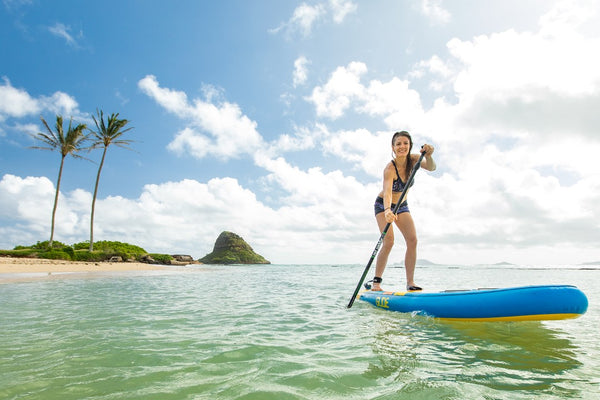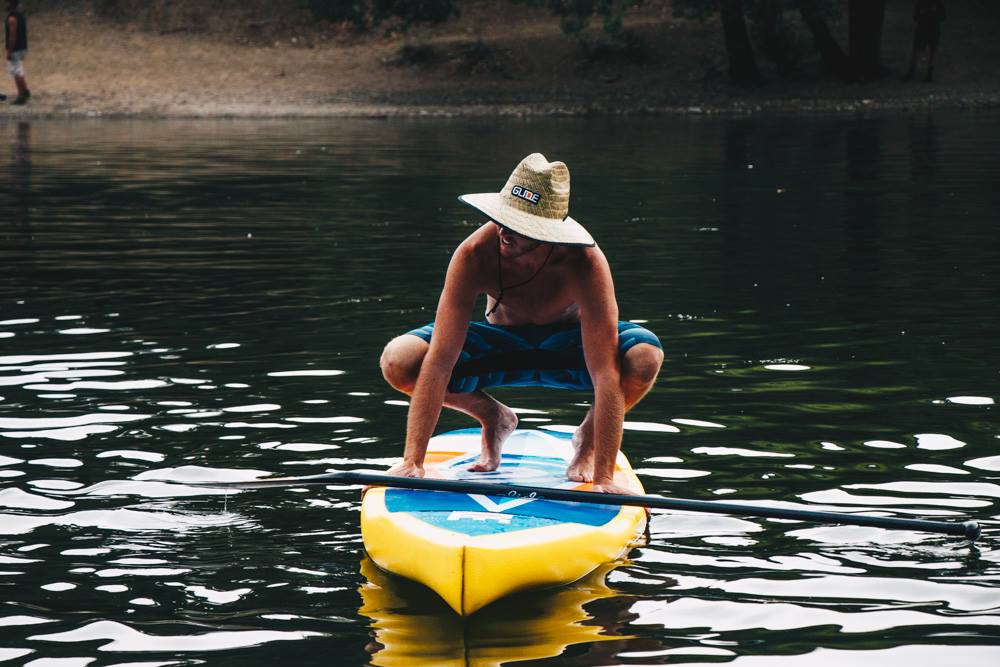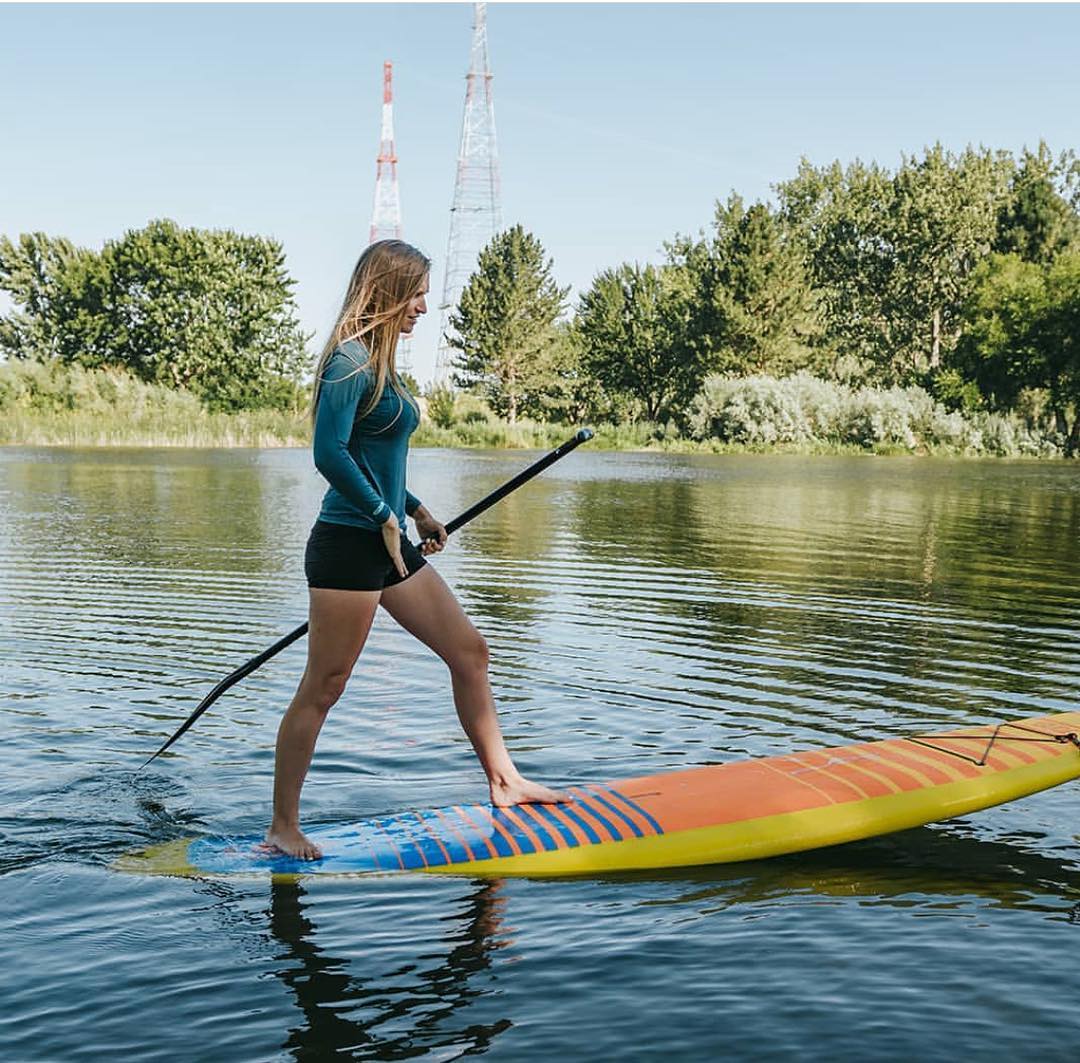
Beginners Guide to Stand-up Paddle Board
Embarking on a stand-up paddleboarding (SUP) journey brings an exciting blend of adventure, relaxation, and a full-body workout. Contrary to some apprehensions, SUP is not difficult; it's about choosing the right board and paddle, mastering basic techniques, and understanding SUP fundamentals. Here’s a beginner’s guide to ensure your first SUP experience is not just enjoyable but also sets the stage for many more to come.
Key Highlights:
-
Understanding SUP Basics: Discover the joys of stand-up paddle boarding, a fun way to enjoy the water and get a full-body workout. Learn what makes SUP accessible and enjoyable for people of all ages and skill levels.
-
Getting Equipped: Everything you need to start your SUP adventure, from selecting the right paddle board and paddle based on your weight, skill, and activity type, to the importance of wearing a Personal Flotation Device (PFD) as per U.S. Coast Guard regulations.
-
Transporting and Carrying Your Board: Tips for transporting your SUP by vehicle, whether it's an inflatable board that fits neatly in your trunk or a durable paddle board that requires a roof rack or truck bed for transportation. Plus, advice on carrying your SUP to the water with ease.
-
Basic SUP Paddling Techniques: Step-by-step instructions for standing up on your board, maintaining balance, correctly holding the paddle, and essential paddling and maneuvering techniques to get you moving smoothly on the water.
-
Tips for Your First SUP Outing: Recommendations for a successful first paddle boarding experience, including choosing the right location, preparing for wind conditions, and the benefits of paddling with a friend.
Understanding SUP Basics

Stand up paddling on a SUP board offers a fun way to play on the water, with the added benefit of a full-body workout. And, since you stand at full height on your board, it gives you a unique vantage point for viewing what’s down under the water and out on the horizon without being confined to the hull of a kayak.
Learning to paddleboard is not nearly as daunting as you might think but before you head out on the water for the first time, it’s helpful to know a little bit about SUP gear and basic technique. To get started paddle boarding, you’ll want to learn:
- How to get geared up to SUP; you’ll need your paddle board, of course, as well as a couple of other essentials.
- Basic SUP paddling techniques; just a few skills will ensure you don’t end up paddling in circles.
- A few helpful tips for your first SUP outing (spoiler alert: try to make wind your friend. Nobody wants to be a Human Sail).
- Stand up paddle board: Your first time or two out, you may want to rent gear or borrow from a friend. If you fall in love with SUP like most do and want to do more of it, consider buying your own. Your board choice is determined by a combination of paddler weight and skill, your intended use, and the local conditions. Different boards excel at different disciplines: such as recreational paddling, surfing, touring, racing, and SUP yoga.
- Paddle: The correct length paddle will reach up to your wrist when you stand the paddle up in front of you and raise your arm above your head. See our article on sizing your paddle here.
- PFD (Personal Flotation Device): The U.S. Coast Guard classifies stand-up paddleboards as vessels, so if you’re paddling outside a surf or swimming area, you have to have a PFD on board. Adults don’t have to wear the PFD, but children must. Check your state’s regulations for age requirements. PFD’s can vary from the old-school orange ones that go around the next to an around-the-waist version that inflates when you pull a cord.
- Proper clothing: During the summer months on a warm body of water, most people choose to wear some combination of a swimsuit, board shorts, and a short- or long-sleeved rash guard for sun protection. For cool conditions where hypothermia is a concern, wear a wetsuit or drysuit. We have more info here on what to wear.
- Leash: Most boards come with a leash that tethers your SUP to you, keeping it close by if you fall off. Your SUP is a large flotation device, so being attached to it can be important for your safety. It can also be important if you fall off your board in windy conditions (especially if you are on an inflatable SUP). There are leashes designed specifically for surf, flatwater, and rivers; be sure to purchase the correct one for your intended use.

Transporting and Carrying Your Board
Transporting by Vehicle
If you live right on the water and are content to launch from the same spot every time you want to use your paddleboard, you don’t have to worry about transporting your board by vehicle. However, if your SUP interest turns into a serious hobby, that’s likely to get boring after a while.
Transporting inflatable paddle boards is a straightforward proposition. When deflated, an inflatable board neatly folds into a package small enough to fit in a compact car’s trunk or back seat. It does take some time to inflate the board once you arrive at your destination, but this added step is offset by the time saved not strapping your board to (and unstrapping from) your roof rack.
Transporting durable paddle boards is more of a hassle, but certainly not insurmountable. Pickup truck drivers can usually fit their boards in the bed, provided they secure them with a rope through the handles and ensure that they’re not projecting too far out into traffic.

If you have a smaller car, your best bet is to strap your board onto the roof rack. For cars with existing roof racks, a cheap, DIY solution is simply to wrap the rack runners in towels to prevent board scratches, attach foam padding (or more towels) to the vehicle roof to prevent roof paint scratches, and secure everything with nylon ropes or heavy-duty straps to the racks or through the vehicle windows.
For cars without existing roof racks, purchase soft crossbar pads that hold the board (as long as it’s properly secured with nylon rope or heavy-duty straps) without scratching it or the vehicle roof. If you frequently paddleboard with friends, consider a more sophisticated rack that can accommodate multiple boards.

Carrying by Hand SUPs
Let's face it, SUPs are bulky. There are a few different ways to carry them:
- Handles: Paddle Boards come with small handles in the midsection. If you’re strong enough to steadily carry the board like a suitcase (roughly waist- or thigh-high), this is the simplest option. Hold your paddle in your non-carrying hand.
- Shoulder: To shoulder-carry, a board with or without handles, hold your paddle in your non-carrying (weak) hand. Gently place the board’s nose on the ground and lift up the tail, then move forward underneath the board, toward its midsection. When you reach the midsection, use your legs to shift the forward half of the board off the ground, balancing it on your head. Finally, shift the board to your carrying shoulder and support it with your carrying arm as you walk. To put the board back down, simply reverse these steps.
- Head: Follow the shoulder-carrying steps, but stop before you shift the board to your shoulder. If it feels unsteady to secure the board on your head with one hand, you can use your weak hand as a second contact point, holding the paddle flush against the top of the board.

Basic SUP Paddling Techniques
With very little instruction, most beginners are able to stand up and start paddling shortly after taking a SUP out for the very first time. To get started, here are some tips on:
- Standing up
- Balance
- Holding the Paddle
- Falling and getting back on
- Moving and Maneuvering

How to Stand Up on Your SUP
Once you get your paddleboard to a launching point, you need to get up on it. Follow this basic procedure to stand up on your board:
1. Walk out into the water, until you’re about up to your knees. Put the paddle horizontally across the board, roughly one foot in front of the centerline.
2. Straddle the board and face forward.
3. Place your knees on either side of the board, still facing forward. Your knees should be about a foot apart, just ahead of the centerline.
4. Place your hands directly in front of your knees on the paddle shaft, fingers spread, exerting downward pressure on the paddle and board.
5. Bring one foot forward directly behind the same hand, replacing the knee. Repeat on the other side.
6. Rise into a squatting position, lifting the paddle with both hands as you go.
7. Pause to assess your balance, then slowly rise into a standing position, lifting the paddle to balance your shifting weight. Keep your eyes fixed on a point in the middle distance or on the horizon.
8. Slowly adjust your position so that your weight is centered and stable on the board.
9. Dip your paddle in the water, touching (or at least temporarily establishing contact with) the bottom, with the bent face pointing forward. This should increase your stability and dispel any lingering unsteadiness, at least until you start moving.

Staying Balanced on a SUP
Once you’re standing, there are a handful of things you can do to maintain your balance on the board:
1. Position your feet so they are parallel, about hip-width distance apart, and centered between the edges of the board.
2. Keep your toes pointed forward, knees slightly bent and your back straight.
3. Keep your head and shoulders steady and upright and shift your weight by moving your hips.
4. Your gaze should be level at the horizon. Avoid staring at your feet (trust us on this one).

How to Hold a SUP Paddle
It’s fairly common to see beginner paddlers holding their SUP paddles the wrong way because let’s face it, the paddle is pretty counterintuitive. To avoid making the same mistake, here are two things to know when grabbing your paddle:
1. Make sure the logo side of the paddle angles away from you and toward the nose of the board.
2. When you’re paddling on the right side of your board, your left hand will be on the T-grip and your right hand a few feet down on the shaft. When you switch sides, reverse your hand positions.

Falling and Getting Back On
Despite your best efforts to stay balanced on your board, you’re going to fall in the water at some point. Even experienced paddlers take the plunge from time to time, so if you’re feeling a little wobbly, don’t worry about it, and remember that SUP is a watersport, so it’s okay to get wet.
For those inevitable times when you lose your balance:
1. Aim yourself to the side, so that you fall into the water and not onto the board. Falling onto the board is more likely to cause an injury.
2. Try to hang onto your paddle while falling. If you get separated from it, retrieve your board first and get back on, then paddle with your hands to get the paddle.
To get back on your SUP after falling off:
1. Position yourself next to your board and near the center.
2. Grab the handle at the center of the board with one hand.
3. Let your legs float up to the surface behind you, then kick your legs while pulling on the handle to slide yourself onto the board.

Moving and Maneuvering
1. Stand atop your board with the paddle in the water, your knees slightly bent, and your eyes fixed forward on the horizon.
2. Keeping your arms straight, but without locking your elbows, place one hand on your paddle’s grip (top) and the other approximately at the midpoint of the shaft. Your grip hand is always the hand opposite your paddling side – for instance if you’re paddling on the right, grip with your left.
3. Place the paddle in the water ahead of your feet with the bent face pointing forward. It should look like a forward-facing spoon with the entire blade submerged.
4. Rotate your torso, engaging your core, as you move the paddle front to back in the water. The motion should keep the paddle parallel to your board, and your arms should remain straight. Your abdominal muscles are responsible for the lion’s share of the work – if you feel like you’re pulling with your arms, concentrate on keeping them fixed as you rotate your torso into your shoulders in a smooth chain of motion.
5. At the end of each stroke, lift the blade all the way out of the water and bring it back to the starting position, and repeat. Shorter strokes tend to be more efficient than longer strokes.
6. To maintain a straight heading, switch paddling sides frequently. If you paddle on one side for too long, your board will turn away from that side.
7. To reverse direction, paddle from back to front using the same basic paddling motion. This also rotates the board in the direction of the paddling side.
8. To turn your board faster, you can lift one foot, bring it back behind your body, and place a disproportionate amount of weight on it, adopting a more aggressive “ready” stance. This lifts the nose of your board out of the water a bit, reducing resistance and facilitating faster paddling turns. Keep in mind that this is an inherently less stable stance, so it’s best not to attempt until you’re comfortable on your board (demonstrated in the photo).

Tips For Your First SUP Outing
Before you grab your board and head to the water for the first time, here are some simple tips for planning your SUP outing:
- Choose a small, calm body of water, like a lake or pond, that’s free of lots of obstacles like boats and buoys.
- Look for a sandy beach or another place you can wade into the water to easily launch your SUP.
- Choose a sunny day with little to no wind.
- If your route requires that you paddle into the wind, do so on your way out so you can get a boost from the wind on the way back when you’re getting tired.
- Go with a friend so you can keep an eye on each other..
Conclusion
Now that you understand the basics, you are free to explore the world from a new point of view! We can honestly say that our extremely durable boards are not scared of you. It all comes down to having the right-sized board, paddle, using the correct techniques, and knowing your SUP stuff and you'll be unstoppable. Paddle the planet!
Related Topics
Common Stand Up Paddle Boarding Mistakes
Things To Know About Paddle Boarding in Winter
Best Places to Paddle Board in Texas


